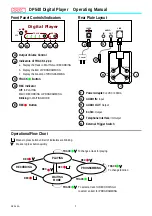
Typical Circuit Connection 3 (Example of DSP Surround Processing Amp)
V
BUS
(3)
D+
GND
USB ’B’
Connector
D–
C
7
R
1
SUSPEND
R
8
R
9
Headphone
31
30
29
28
27
FSEL
TEST
S
SPND
XTI
XTO
CK
DT
PSEL
(2)
V
CO
M
AGNDR
V
CCR
V
OU
T
R
(1
)
V
OU
T
L
(1)
V
CCL
AGNDL
ZGND
32
26
PGND
V
CCP
HOST
(2)
FUNC3
FUNC0
HID0/MS
(4)
HID1/MC
HID2/MD
PCM2707PJT
25
23
22
21
20
19
24
18
17
10
11
12
13
14
91
51
6
2
3
4
5
6
1
7
8
V
BUS
D+
D–
V
DD
DGND
FUNC1
FUNC2
DOUT
C
5
+
C
6
C
3
C
4
X
1
C
1
C
2
R
5
+
C
8
+
C
9
R
10
R
11
C
10
R
6
C
11
R
7
R
3
R
4
R
12
R
2
(3)
DOUT
SYSTEM CLOCK
BCK
MD
MC
MS
LRCK
DIN
T AS300X
(4)
I
2
S I/F Audio Device
Power
3.3 V
GND
+
(3)
+
,,
SLES081F – JUNE 2003 – REVISED JANUARY 2009
.......................................................................................................................................................
www.ti.com
illustrates a typical circuit connection for an I
2
S- and SPI-enabled self-powered application.
NOTE: X
1
: 12-MHz crystal resonator. C
1
, C
2
: 10-pF to 33-pF capacitors (depending on load capacitance of crystal resonator). C
3
, C
4
: 1-
µ
F
ceramic capacitors. C
5
, C
7
: 0.1-
µ
F ceramic capacitor and 10-
µ
F electrolytic capacitor. C
6
: 10-
µ
F electrolytic capacitors. C
8
, C
9
: 100-
µ
F
electrolytic capacitors (depending on required frequency response). C
10
, C
11
: 0.022-
µ
F ceramic capacitors. R
1
, R
12
: 1 M
Ω
resistors. R
2
, R
5
:
1.5 k
Ω
resistors. R
3
, R
4
: 22
Ω
resistors. R
6
, R
7
: 16
Ω
resistors. R
8
-R
11
: 3.3 k
Ω
resistors.
(1) Output impedance of V
OUT
L and V
OUT
R during suspend mode or lack of power supply is 26 k
Ω
±20%, which is the discharge path for C
8
and C
9
.
(2) Descriptor programming through SPI is only available when PSEL and HOST are high.
(3) D+ pull-up must not be activated (HIGH: 3.3V) while the device is detached from USB or power supply is not applied on V
DD
and V
CC
x.
VBUS of USB (5V) can be used to detect USB power status.
(4) MS must be high until the PCM2707 power supply is ready and the SPI host (DSP) is ready to send data. Also, the SPI host must handle
the D+ pull-up if the descriptor is programmed through the SPI. D+ pull-up must not be activated (HIGH = 3.3 V) before programming of the
PCM2707 through the SPI is complete.
Figure 34. Self-Powered Application
NOTE:
The circuit illustrated in
is for information only. The entire board design
should be considered to meet the USB specification as a USB-compliant product.
30
Copyright © 2003–2009, Texas Instruments Incorporated
Product Folder Link(s):
PCM2704 PCM2705 PCM2706 PCM2707














































